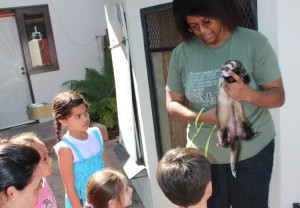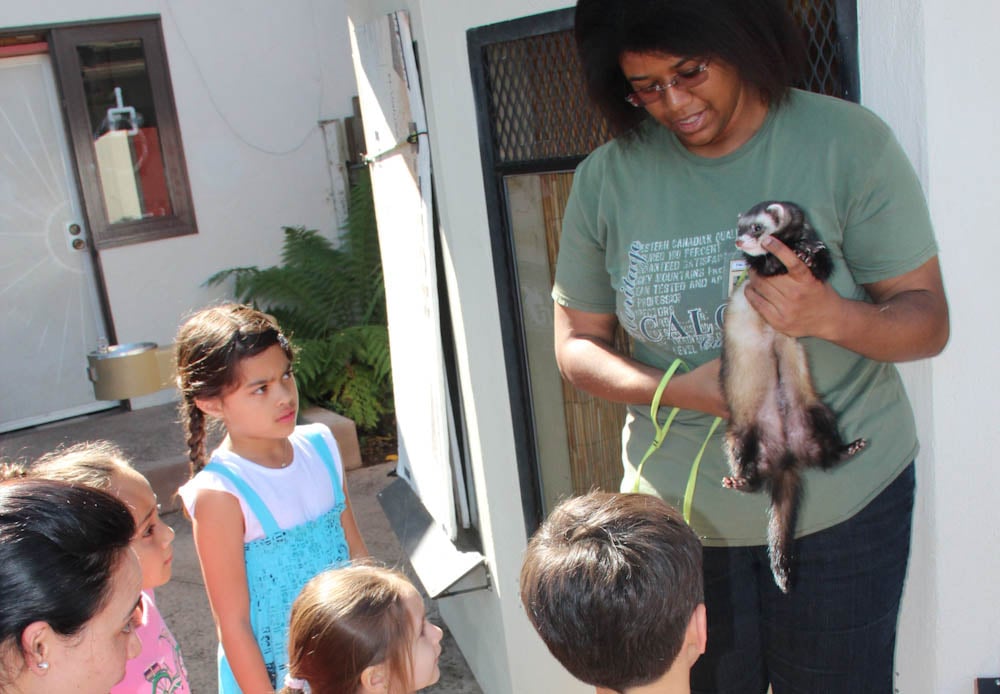Like many other Stanford students, Alexandria Hicks-Nelson ’12 bikes to her job after class. Unlike most Stanford students, once she arrives at her job she readies herself to handle a seven-and-a-half-foot boa constrictor, dole out goose and duck food, release a raccoon from its enclosure and walk ferrets named Rufus and Tully on their leashes.
Hicks-Nelson, co-president of the Stanford Undergraduate Pre-vet Club, has volunteered at the Palo Alto Junior Museum and Zoo for the past two years to gain experience for her future career in veterinary science. Thanks to her experience with the club, Hicks-Nelson will be working at the Adobe Animal Hospital this summer in preparation for applying to veterinary school in October.
Founded on campus 11 years ago by Donna Bouley, professor of comparative science and pathology by courtesy, the pre-vet club is an opportunity for undergraduates, graduates and even postdoctoral fellows to network with current veterinarians and alumni, learn about the necessary coursework and steps toward veterinary school and explore the wide range of fields that fall under the category of veterinary science aside from animal clinics and horse medicine.
“We’re trying to provide them with what we’re really good at, but it also gives them a unique kind of a leg up in applying to vet school as well,” Bouley said.
Bouley started the club after some of her students were admitted into veterinary schools but were missing required coursework that Stanford did not offer, such as lab-based microbiology. From there, Bouley’s goal was to find interested students and keep tabs on them so they could be fully prepared for veterinary school and have the necessary shadowing hours and lab work completed on time.
The Department of Comparative Medicine, which co-funds the club along with the Office of Undergraduate Advising and Research, now hosts a range of classes and research opportunities for club members. Next year, three new introductory seminars will be added: Introduction to Animal Behavior, Comparative Hematology and a course on anesthesia titled, Ouch! That Hurts.
Club members meet twice a quarter over dinner, during which they hear presentations from faculty members and researchers at the Department of Comparative Medicine, club alumni and other club members. The presentations include guidelines to follow in applying to veterinary school, previews of classes that students should take for their specialized field and research opportunities.
“A lot of times pre-vets will fall into the trap of not really going for the internships that would best suit their expertise or interests, so we do a lot of sharing of that,” Hicks-Nelson said.

Additionally, Bouley meets with the students one-on-one to advise them on their progress. Bouley said she hopes the club can also expose students to a wide range of career opportunities they may not realize exists.
“Clinical medicine is a great practice, but a lot of students think that’s all there is,” Bouley said. “They don’t realize that you can get into board specialties, research, public health and all of these different things that veterinarians are crucial to in today’s world.”
To draw in more members and create a presence on campus, the club hosts a Pre- Vet Club Expo every other year, in which they invite speakers currently working in the field, current vet school students and Stanford alumni to host panels or workshops and have lunch conversations with visiting high school students and Bay Area pre-vet college students.
The goal of the expo is to get students to think about a career as veterinarians ahead of time to ensure they plan their curriculum accordingly. Because of the small number of accredited veterinary schools in the country, the application process is exceptionally competitive.
“Nowadays for vet students to be competitive these kids have thousands of hours of vet shadowing, and that’s pretty hard to do if you only started in your junior year of college,” Bouley said. “They need to be thinking about this even in high school.”
However, Bouley still encourages late involvement both in the club and the career path. She herself spent most of her early career as a gymnastics coach and judge until she discovered an interest in pathology research.
“The message that I try to give to them is that first of all, all experience is good experience, even if it was a bad experience, because you then know what you don’t want to do,” Bouley said.
While Stanford has a record of nearly 100 percent acceptance of its students to veterinary schools, club alumna Claudia Chern ’11, who now works as a veterinary assistant at a San Francisco clinic, said she found it difficult being a pre-vet student at a pre-med dominated school like Stanford.
“I still think that it’s pretty hard to be pre-vet at Stanford because the opportunities are for human medicine, but it was helpful for Dr. Bouley to mentor us because she really helps everyone find places to get needed experience at a place where it’s all human medicine,” Chern said.
Hicks-Nelson said that if it weren’t for the club and its connection with the Department of Comparative Medicine, she probably wouldn’t have been able to attend a summer internship at the New England Wildlife Center. Only the Department of Comparative Medicine would pay for the necessary rabies vaccinations that the biology department couldn’t offer.
“As much as I wish that there was a specific animal sciences major, just being in the biology department and being a pre-vet have been different ways of helping me out,” Hicks-Nelson said.
By banding together in collaboration with the Department of Comparative Medicine, Stanford’s small group of veterinarian hopefuls said they have been supported in chasing an unorthodox career path.
“We have had students [who] have gone on to vet school and are currently in pathology residencies [or] Ph.D. programs, and one of our alums is coming back as a lab animal resident,” Bouley said. “It’s a small group, but I think we have a big impact relative to the numbers of people that are going on to these alternative types of vet careers.”
